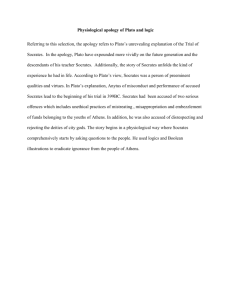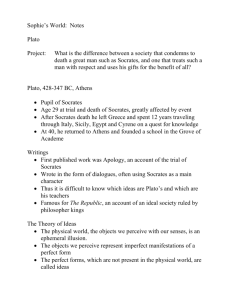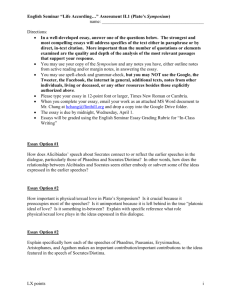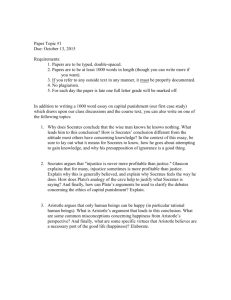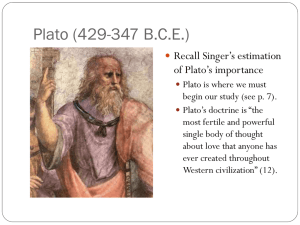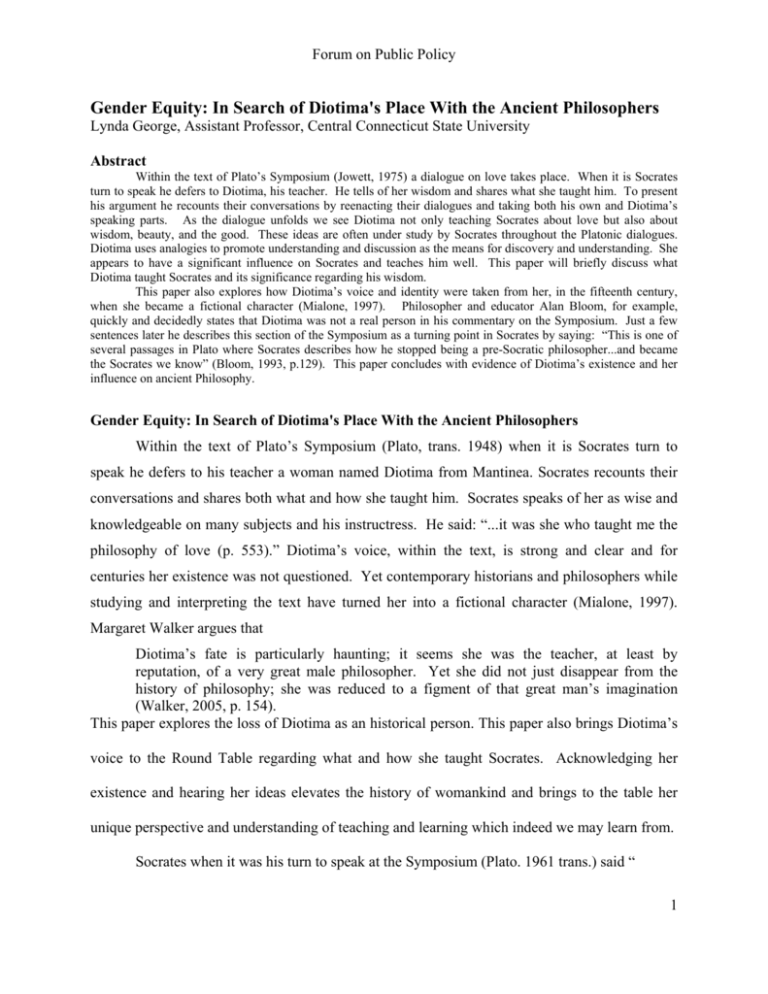
Forum on Public Policy
Gender Equity: In Search of Diotima's Place With the Ancient Philosophers
Lynda George, Assistant Professor, Central Connecticut State University
Abstract
Within the text of Plato’s Symposium (Jowett, 1975) a dialogue on love takes place. When it is Socrates
turn to speak he defers to Diotima, his teacher. He tells of her wisdom and shares what she taught him. To present
his argument he recounts their conversations by reenacting their dialogues and taking both his own and Diotima’s
speaking parts. As the dialogue unfolds we see Diotima not only teaching Socrates about love but also about
wisdom, beauty, and the good. These ideas are often under study by Socrates throughout the Platonic dialogues.
Diotima uses analogies to promote understanding and discussion as the means for discovery and understanding. She
appears to have a significant influence on Socrates and teaches him well. This paper will briefly discuss what
Diotima taught Socrates and its significance regarding his wisdom.
This paper also explores how Diotima’s voice and identity were taken from her, in the fifteenth century,
when she became a fictional character (Mialone, 1997). Philosopher and educator Alan Bloom, for example,
quickly and decidedly states that Diotima was not a real person in his commentary on the Symposium. Just a few
sentences later he describes this section of the Symposium as a turning point in Socrates by saying: “This is one of
several passages in Plato where Socrates describes how he stopped being a pre-Socratic philosopher...and became
the Socrates we know” (Bloom, 1993, p.129). This paper concludes with evidence of Diotima’s existence and her
influence on ancient Philosophy.
Gender Equity: In Search of Diotima's Place With the Ancient Philosophers
Within the text of Plato’s Symposium (Plato, trans. 1948) when it is Socrates turn to
speak he defers to his teacher a woman named Diotima from Mantinea. Socrates recounts their
conversations and shares both what and how she taught him. Socrates speaks of her as wise and
knowledgeable on many subjects and his instructress. He said: “...it was she who taught me the
philosophy of love (p. 553).” Diotima’s voice, within the text, is strong and clear and for
centuries her existence was not questioned. Yet contemporary historians and philosophers while
studying and interpreting the text have turned her into a fictional character (Mialone, 1997).
Margaret Walker argues that
Diotima’s fate is particularly haunting; it seems she was the teacher, at least by
reputation, of a very great male philosopher. Yet she did not just disappear from the
history of philosophy; she was reduced to a figment of that great man’s imagination
(Walker, 2005, p. 154).
This paper explores the loss of Diotima as an historical person. This paper also brings Diotima’s
voice to the Round Table regarding what and how she taught Socrates. Acknowledging her
existence and hearing her ideas elevates the history of womankind and brings to the table her
unique perspective and understanding of teaching and learning which indeed we may learn from.
Socrates when it was his turn to speak at the Symposium (Plato. 1961 trans.) said “
1
Forum on Public Policy
…I shall begin by stating who and what Love is, and go on to describe his functions, and
I think the easiest way will be to adopt Diotima’s own method of inquiry by question and
answer…she used the same arguments on me that I’ve just brought to bear on Adathon to
prove that, on my own showing, Love was neither beautiful nor good (p. 554).”
As the dialogue unfolds we hear Diotima teaching Socrates about love including the love of
about wisdom, virtue, beauty, and the good. These ideas are often under study and/or discussion
throughout Plato’s works. Diotima uses mythology and analogy to promote understanding and
discussion as the means for bringing forth thoughts from her student Socrates. She appears to
have had a significant influence on Socrates and taught him well, for what he says he learned
from her he is able to recollect, interpret and expand on as he nurtures, (albeit at times) agitates,
annoys, frustrates and/or angers others throughout the Platonic dialogues. While the existence of
no other personage within any of the dialogues is questioned “recent philosophic tradition has
assumed that Diotima was not an historical person (Waithe, 1987 p. 5).”
When, How, and Why Diotima was Banished from Reality
From the time Plato wrote the Symposium until 1485 with the publication of Oratio
Septima II written by Maresilio Ficino, no one questioned Diotima’s existence. From her study
of Diotima Mary Ellen Waithe tells us:
Nowhere is the suggestion found that Diotima was anything but a real person who had
the conversations with Socrates recorded by Plato. For nearly nineteen centuries Diotima
was…considered a historical person. Ficino’s remark on the absurdity of thinking a
woman a philosopher achieved and retained the status of received doctrine for the next
500 years (Waithe, 1987, p. 106).
From this it is apparent that Ficino, not Plato, created the fiction of Diotima based on his
inability to appreciate a woman philosopher.
2
Forum on Public Policy
Kathleen Wider (Wider, 1986) in her research on ancient Greek women philosophers
explored the arguments by several modern scholars regarding whether Diotima was an actual
historical figure. Wider offers that
The arguments supporting the view that she is a fictitious personage invented by Plato are
weak…Scholars have given all kinds of reasons for Plato’s invention of Diotima. F. M.
Cornford speculates that Diotima was invented as a device by which Socrates could avoid
offending his host Agathon while criticizing his views…R. G. Bury argues that Diotima
must be fictitious because Plato would not put his vision of Eros into the mouth of any
historical person since that would imply it was derived rather than original…Martha
Nussbaum takes for granted Diotima’s fictitious nature…None of these analyses give us
any good reason (and most no reason at all) for thinking Diotima fictitious (p. 45-46)
Modern philosopher Alan Bloom (Bloom, 1993) quickly and decidedly stated that
Diotima was not a real person in his commentary on the Symposium. “The name Diotima means
‘honored by Zeus’, and the mention of the city of Mantinea in the grammatical form it appears in
here, is identical with the word for science of divining. She is clearly a made-up person (p.
129).” Just a few sentences later he describes the Symposium as a turning point in Socrates by
saying: “This is one of several passages in Plato where Socrates describes how he stopped being
a pre-Socratic philosopher...and became the Socrates we know (p. 129).” One may with some
certainty conclude that the fundamental reason Diotima is not accepted to be as real historical
person who lived and taught Socrates is due to the fact that she happened to be a woman and
men have dominated the study of philosophy.
The Case for Diotima’s Existence
The case for Diotima’s existence researched by Mary Ellen Waithe (1987) comes from three
sources: other texts by Plato, other writers from antiquity, and an archeological artifact with an
Oxford connection.
3
Forum on Public Policy
From Plato
Some purport that Socrates would not seek the advice of a woman. Yet in two other
Socratic dialogues Socrates refers/defers to the wisdom of priestesses (Waithe, 1987).
In the
Apology (Plato, 1954 trans.), as part of his defense Socrates refers to the Priestess of Delphi, the
prophetess who said he was the wisest man in Athens. In Meno (Plato, 1994, trans) a snippet
from the dialogue reads:
Socrates: …I have heard from certain wise men and women who spoke of
things divine thatMeno: What did they say?
Socrates: They spoke of a glorious truth, as I conceive.
Meno: What was it? And who were they?
Socrates: Some of them were priests and priestesses (pg. 17-18).
Based on these texts Waithe (1987) suggests “we can safely assume that Socrates had no
reservations about consulting priestesses and even had faith in their teachings…(and thus) there
is nothing unlikely about his having consulted with Diotima, a priestess from Mantinea (p. 103).”
In still a third text Socrates speaks of another woman whom he learned from.
In Menexenus (Plato, 1961 trans.) Socrates speaks highly of Aspasia the woman who taught him
rhetoric. Socrates: “That I should be able to speak is not (a) great wonder, Menexenum,
considering that I have an excellent mistress in the art of rhetoric – she who has made so many
good speakers…(Plato, Jowett trans p. 188).”
Aspasia’s existence is not questioned. The words of Socrates regarding these three texts are not
questioned, so why is Diotima’s existence questioned?
Beyond the Symposium other writers
from antiquity refer to Diotima as having existed.
Other Writers from Antiquity
4
Forum on Public Policy
Throughout antiquity there are a number of texts that mention her and appear to imply
that she indeed existed. For example, in the 2nd century A.D. in Lucian’s The Eunuch, a comedy
or farce “…opens with the matter-of-fact mention of Diotima, Thargelia, and Aspesia as
evidence that even women were philosophers...(Waithe, 1987 p. 105). There is no suggestion
that these women were anything but practicing philosophers. Waithe offers six other texts
written between the second and fifth century whose authors give “…accounts of Diotima without
any suggestion that she is not a historical person (p.106)”
In Giles Menage’s (1948, trans) The History of Women Philosophers, written in the
1600’s, Diotima’s existence is not questioned. He refers to the Symposium as evidence of her
existence as well as a statement in Lucian. Beatrice Zedler, in her introduction to the Menage
text she translated, states “what Menage wishes to show is that in fact there has been no lack of
women philosophers, but only a lack in our knowledge about them (pg. vii).” Menage wrote
“Diotima taught Socrates the philosophy of love; Socrates himself declares this, according to
Plato in the Symposium (p. 9).” Lucian, in the early sixth century refers to Diotima as a model
for wisdom and understanding “...Diotima shall be copied not only in those qualities for which
Socrates commended her, but in her general intelligence and power to give counsel (Lucian,
1925 trans, p. 289). The text does not question Diotima’s existence but the translator’s footnote
on her reads, “Diotima, a priestess of Mantinea, probably fictitious, for we hear of her only
through Plato in the Symposium…(p. 288).” There is a piece of archeological evidence in
support of Diotima.
Archeological Evidence
5
Forum on Public Policy
The Oxford University Collection housed an ancient roll of Plato’s Symposium. A bronze relief,
the original cover for the text, has been studied and is believed to be of Diotima and Socrates
with the figure of Eros between the two. She is animated in discourse; he is listening (Waithe,
1987).
“Although this archeological evidence does not prove that Diotima really existed, it
shows why the burden of proof should rest on those who, almost two millennia later, and on the
basis of no evidence whatsoever, assumed that she did not (p. 106).”
What and How Diotima Taught Socrates
As an educator I have spent much time over many years pursuing an understanding of the
Socratic method as a means for teaching middle school students and now college education
majors. Philosophy means the love of wisdom and nurturing both the love of wisdom and
thoughtful reflective inquiry that leads to thinking is a powerful means for gaining knowledge.
Diotima’s teachings are about the love of wisdom and the power of knowing through discovery
and understanding.
Socrates tells us that he used “Diotima’s own method of inquiry (Plato, 1961, p. 554)” on
Adathon to prove Adathon wrong. Socrates’ conversations with Diotima not only changed his
thoughts on the subject of love but also his thoughts on thinking and the means to get others to
think by incorporating her method into his teaching.
himself coming to know rather than by being told.
He said she changed his thinking by
She guided him and he came to
understand by experiencing inquiry learning. He became known as a great philosopher and
gained immortality by Plato recording his conversations.
After getting Socrates to understand his misconceptions of love Diotima explained why
he and others had it wrong. She does this in a nurturing and supportive way.
6
Forum on Public Policy
The error in your conception of (love) was very natural, and as I imagine from what you
say, has arisen out of a confusion of love and the beloved, which made you think that
love was all beautiful. For the beloved is the truly beautiful, and delicate, and perfect, and
blessed; but the principle of love is of another nature, and is such as I have described.
(Plato, 1948. p. 46)
Here we have a lesson from Diotima on word usage as a means to know and gain wisdom, by
building understanding through what is known.
In the Meno, Socrates questions a young boy in the same manner as the means for
teaching him geometry. His only requirement was that the boy spoke Greek. At first the boy
believes he knows how to double the size of a square, by doubling the side. They draw it in the
dirt or sand and the square becomes four times the size. The boy discovers that in fact he does
not know. Socrates continues the lesson asking the young student questions. Through what
Socrates calls recollection, derived by Socrates questions, the boy solves the problem (Plato,
1994).
Diotima made connections to provide a multi sensory and kinesthetic means for learning.
She looked to body, mind, and soul in relation to change. The idea of recollection, the birthing of
ideas, and the means for mere mortals to achieve immortality are explored.
Socrates’
recollection of Diotima’s word brings her voice to our table:
Although we speak of an individual as being the same so long as he continues to exist in the
same form, and therefore assume that a man is the same person in his dotage as in his infancy,
yet, for all we call him the same, every bit of him is different, and every day he is becoming a
new man, while the old man is ceasing to exist, as you can see from his hair, his flesh, his bones,
his blood, and all the of his body. And not only his body, for the same thing happens to his soul.
And neither his manners, nor his disposition, nor his thoughts, nor his desires, nor his pleasures,
nor his sufferings, nor his fears are the same throughout his life, for some of them grow,
while
others disappear.
7
Forum on Public Policy
And the application of this principle to human knowledge is even more remarkable, for not
only do some of the things we know increase, while some of them are lost, so that even in our
knowledge we are not always the same, but the principle applies as well to every single branch
of knowledge. When we say we are studying, we really mean that our
knowledge
disappears, and we have to study so as to replace what we are losing, so that the state of our
knowledge may seem, at any rate, to be the same as it was before.
This is how every mortal creature perpetuates itself. It cannot, like the divine, be still
the same throughout eternity; it can only leave behind new life to fill the vacancy that is
left in its species by obsolescence. This my dear Socrates, is how the body and all else
that is temporal partakes of the eternal, there is no other way (Plato, 1961. p. 559-560).
Next Diotima speaks of the immortal works and deeds of famous Greeks to further her argument.
She speaks of those who took great risks, even sacrificed their lives to be remembered as great
heroes and the great poets who have been immortalized through their writing.
She refers to
these ideas as the “more elementary mysteries of love (p. 561) which she believes Socrates
capable of understanding but she is not sure he will be able to apprehend the final revelation.
In the final discourse given to Socrates by Diotima reveals the greater mysteries of love
and what one may achieve if taught correctly. This part of her speech gives us an amazing
perspective on teaching and learning. Diotima tells Socrates that the student must first visit
beautiful forms and be guided by an instructor to love one form and create fair thoughts. Next
they will discover the beauty of the one is akin to the beauty of another, which leads to knowing
there is beauty in every form. They will then be able to leave the violent love of the one, seeing
it as small, and become lover of all beautiful forms (Plato, 1948).
In the next stage they will consider the beauty of the mind and find it more honorable
than the beauty of outward forms. The teacher searches for and brings forth the birth of thoughts
to improve the student who in turn will be compelled to contemplate and see the beauty of
institutions and law. Next comes the understanding of beauty of institutions and laws are in their
oneness. Personal beauty will be seen as a trifle. Next comes the beauty of the sciences. Not a
8
Forum on Public Policy
slave, servant or narrow-minded in love with one but contemplating the vast sea of beauty (Plato,
1948).
They will create many fair and noble thoughts and notions in boundless love of wisdom;
until on that shore (s)/he grows and waxes strong, and at last the vision is revealed to
(her)/him of a single science, which is the science of beauty everywhere (pgs. 51).”
This is what Diotima taught Socrates.
Through questioning Socrates ideas and telling a mythical tale Diotima moves him from
thinking he knows to realizing he does not. She presents the physical elements of love and the
desire to be immortal. She moves from the physical to the soul and mind and how they change
over the course of a lifetime. The love of wisdom, which leads to the study of beauty, is shown
to be the most desirable love. This love is time consuming for both the teacher and the student
and involves particular steps on a nurturing and loving journey to knowledge. The journey,
which is guided by an instructor, is well worth the work for it brings with it an abundance of
freedom and a world of boundless beauty to behold. The teacher must guide but the student must
experience.
If educators were to listen to Diotima and enact her philosophy of education the
love of learning would bring about a well-educated citizenry. Diotima not only deserves to be
heard and known but also deserves a place of honor in the history of western civilization.
References
Bloom, A. (1993). The ladder of love. In S. Benardete (Trans.), Plato’s Symposium (pp. 55-177). Chicago, The
Chicago Press.
Lucian. (1925). The works of Lucian Vol IV. (A. M. Harmon, Trans.). London, England: William Heinemann.
Ménage, G. (1984). The history of women philosophers. (B. H. Zedler, Trans.). Lanham, MD: University Press of
America, Inc.
Mialone, Barbara (1997). Women philosophers of ancient times. (Online)
http://www.geocities.com/athens/forum/9974/old.html
Plato. (1948.) Symposium. (B. Jowett, Trans.). Indianapolis: The Bobbs-Merrill Company, Inc.
Plato. (1954). The apology. In H. Tredennick (Trans.), The last days of Socrates (pp. 45-76). New York, New York:
Penguin Books.
Plato. (1961). Menexenus. (B. Jowett, Trans.). In E. Hamilton & H. Cairns (Eds.), Collected dialogues of Plato (pp.
186 – 199). New York, New York: Random House, Inc.
9
Forum on Public Policy
Plato. (1961). Symposium. (M. Joyce, Trans.). In E. Hamilton & H. Cairns (Eds.), Collected dialogues of Plato (pp.
526 – 576). New York, New York: Random House, Inc.
Plato. (1994). Meno (B. Jowett, Trans.). http://classics.mit.edu/Plato/meno.html
Walker, M. U. (2005). Diotima’s ghost: The uncertain place of feminist philosophy in professional philosophy.
Hypatia, 20(3), 153-164.
Wider, K. (1986). Women philosophers in the Ancient Greek world: Donning the mantle. Hypatia, 1(1), 21 – 62.
Waithe, M. E. (1987). Diotima of Mantinea. In M.E. Waithe (Ed.), A history of women philosophers: Vol. 1.
Ancient Women Philosophers. Dordrecht Netherlands: Martinus Nijhoff Publishers.
Published by the Forum on Public Policy
Copyright © The Forum on Public Policy. All Rights Reserved. 2006.
10


